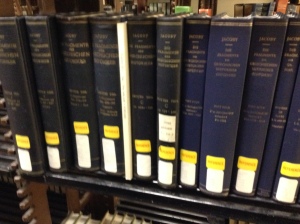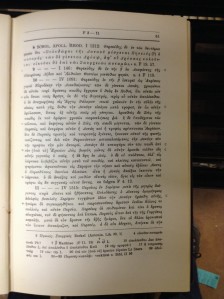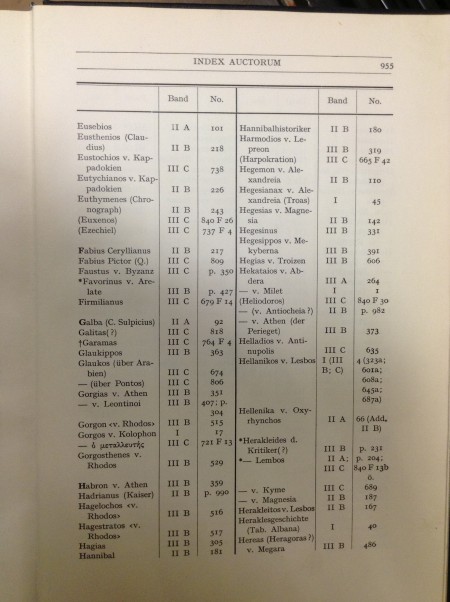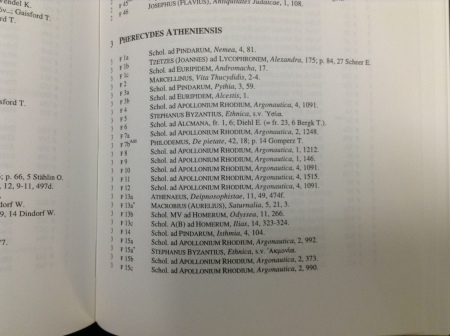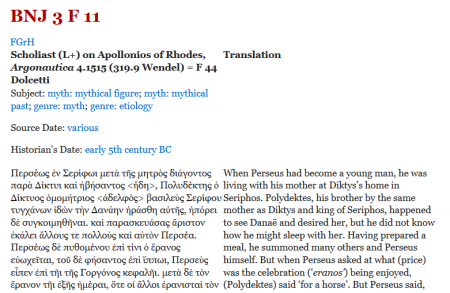TL;DR Version (skip to the long version if you like storytelling and don’t want spoilers):
For a given Jacoby citation in the format (example) 3F11, parse as follows:
- 3 is the author number. Each author has a unique number. There is an author index in the original print set, in volume III, part C, pp. 947-64, if you know the author’s name but not the number. The authors appear in the print volumes in numerical order (depending on your binding, the author numbers in a given book may well be printed on the spine. Author 3 is in the very first book in the set, natch, following authors 1 and 2.)
- F is for fragment; T is for testimonial. Once you find the section on a given author, the fragments appear before the testimonia.
- 11 is the number of the fragment being cited. These appear in numerical order in the print volumes, so 3F11 will follow 3F10 and precede 3F12.
The Long Version
The origin of this post was a plea by IM from a librarian friend who was staffing the chat reference service at an academic library. A student had the citation “3F11” and the knowledge that this referred to Jacoby’s Fragmente Der Greichischen Historiker (usually abbreviated FGrH, so the student had probably already done some work before turning to a librarian.) My friend was able to tell the student that their institution owned the print volumes (WorldCat), although they did not have access to the digital version available through Brill, and that it was a 15-volume set, but the student really wanted a volume and page number.
My friend was hopeful that F stood for “fascicle” and that 3F11 somehow meant volume 3, fascicle 11, and then some unknown page. Jacoby citations are not that straightforward, though; the work is tricky enough to use that a three-volume freestanding index was published by P. Bonnechere in 1999 (WorldCat). In his 2000 review at BMCR, J. Marincola explained the difficulties:
… although a masterpiece, FGrHist has never been an easy work to use. Jacoby insisted on a peculiar arrangement by sub-genres of historical writing (as he conceived them). This by itself would have been difficult, but it was then further complicated by a concession to practicality, namely, an arrangement by author rather than by individual work. And yet if an author wrote works in a variety of (Jacoby’s) sub-genres (as many did), he could, nevertheless, appear in only one section. Jacoby seems to have decided what work of the author was most important and then assigned him to the category that best described that work. So, for example, Arrian wrote a Parthika (on Rome’s wars with Parthia from the first century BCE to his own time) and a Bithyniaka (a history of his homeland Bithynia), but he is to be found amongst the historians of Alexander’s Successors — no doubt because his Affairs after Alexander is his most important (i.e., for us) fragmentary work. Before the volumes under consideration here, the only help we have had in using FGrHist has been an alphabetical list of authors at the end of III.C., pp. 947-64 …
If either the student or the librarian had been standing in front of the print volumes, this problem of “what does 3F11 mean?” would have been pretty easy to solve. I found out that 3 was the ‘author number’ via the review of the index quoted above, but if you pulled the first volume off the shelf and flipped through, it would have been reasonably apparent that the volume was organized by numbers assigned to authors, and happily enough, author 3 is in the first volume. I could walk up to the books and start flipping and using logic get to the correct page pretty quickly. (A student might still have been kind of intimidated by the sheer volume of information available, plus the fact that nothing is in English.)
Sorry for the blurriness of some of the iPad photos. I seem to have shaky hands. Here’s our fragment!
Now, if you did’t have a citation, but knew that you wanted a fragment of Glaukippos, or whoever, you’d turn to the Author Index in the original print set (vol. III part C pp. 947-64) and find out your author’s number, then find the correct volume for that author. So looking at the page below, Glaukippos is author number 363 and is found in vol. III part B.
For a more detailed treatment in list form of the sources of the fragments, the Bonnechard index is the right place to look. Here’s the page on our friend Author 3 (Pherekydes of Athens):
My librarian friend’s institution doesn’t subscribe to the digital Brill’s New Jacoby (which is bundled with digital versions of the original Jacoby volumes in Jacoby Online, and which is not yet complete but estimated to be so in 2017) but I was at the University of Cincinnati Library and they do, so I checked it out. A search for 3F11 netted 5 results (and unfortunately our fragment was last on the result list for some reason).
Here’s the entry for our fragment 3F11, :

